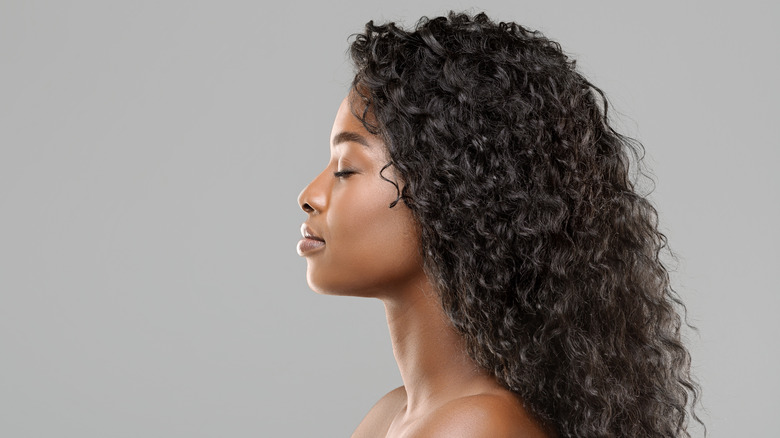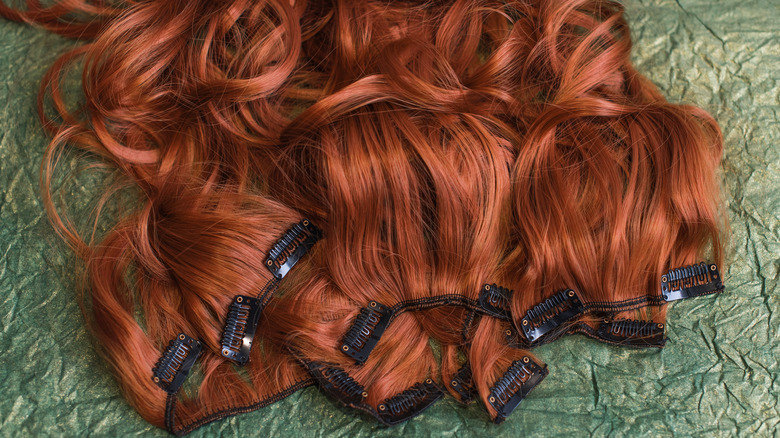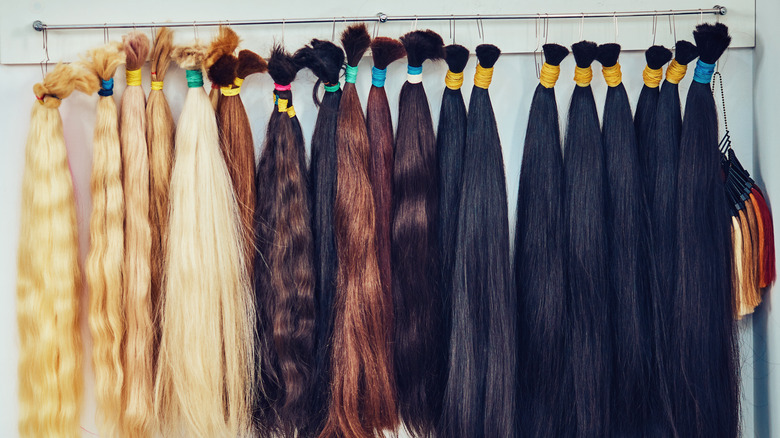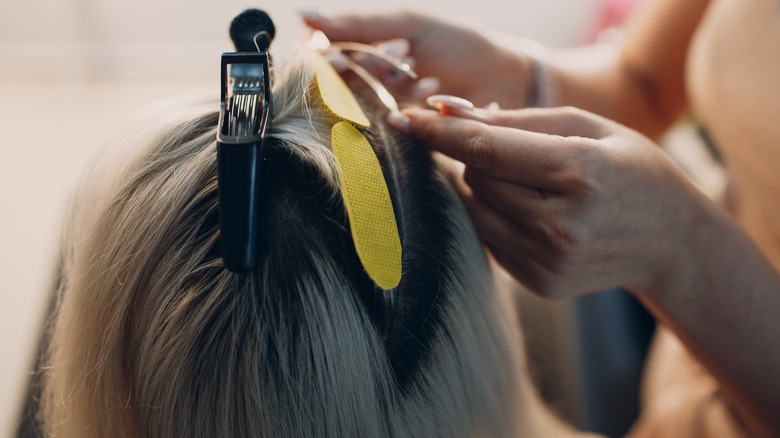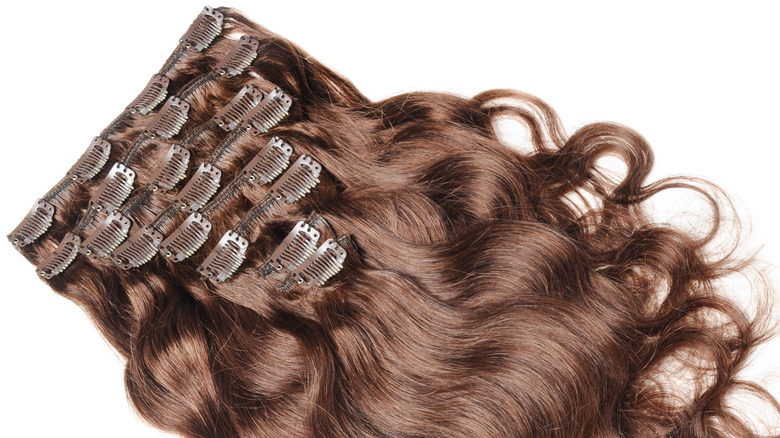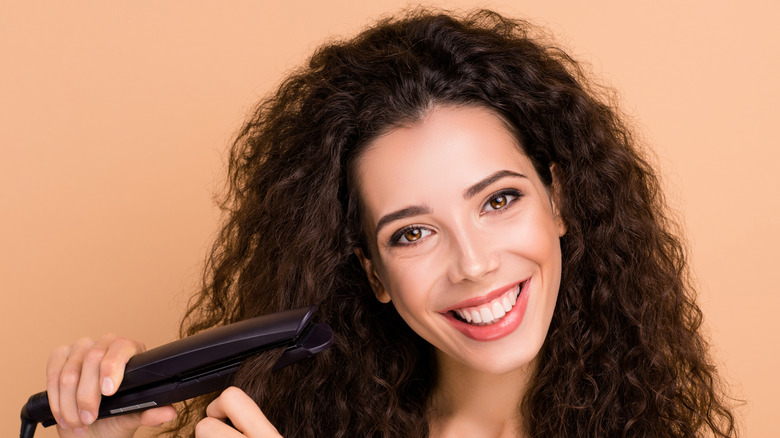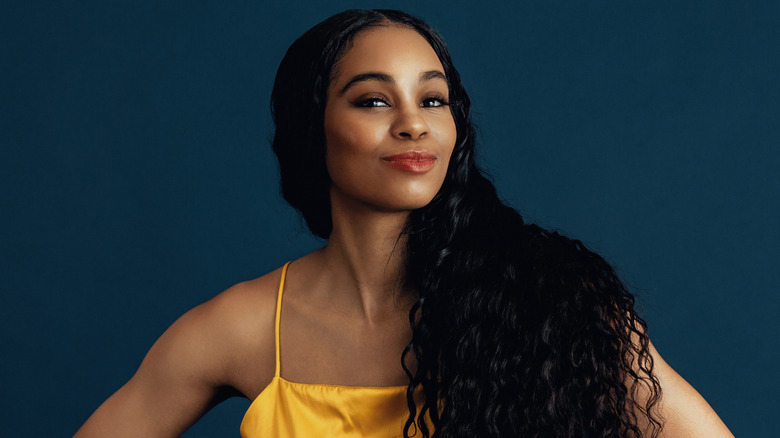All Of Your Questions About Curly Hair Extensions Answered
If you have naturally curly hair, you know that sometimes your hair requires a few extra steps to ensure that it's healthy and looking its best, and that also applies if you're looking to boost your natural hair with some curly hair extensions. No matter the type of extensions you're looking at getting, you don't need to straighten your hair in order to get the hair length you desire. What you do need, of course, is to know what you're getting yourself into first.
The good news is that there is tons of information online, from experts as well as those who have gotten curly hair extensions themselves, to make the process of getting and caring for your curly hair extensions that much easier for you. From figuring out if extensions are right for you to knowing when it's time to replace them, our guide has got your most pressing questions about getting curly hair extensions covered.
Determine if extensions are right for you
Before you look any deeper into getting curly hair extensions, you need to know if they're the right option for you. The first step if you're thinking of getting hair extensions is to make sure that your hair is long enough that the extensions can be hidden in your natural hair to begin with. While opinions on how long is long enough vary by an inch or two depending on the source, Hair Adviser mentions that your hair should be at least 3 inches in length, and Curl Centric gives 2 inches in length as the magic number.
According to Bebonia founder Soleil Guerrero's comments to Makeup.com, though, it's best if your hair is longer than those aforementioned guidelines if you're going for curly hair extensions. Explained Guerrero, "To blend properly, extensions need to have enough hair to camouflage the wefts. We usually recommend people have hair that is at least chin length."
Figure out what type of extensions you want
Once you've determined that extensions are right for you, you'll need to figure out what type of extensions you want to get. There are many different options, and it's important to know what you want out of your extensions and do your research to make sure that the type of installation fits with what you'd like. As hairstylist LeAna McKnight told InStyle, "Based on what you choose, you may need weft hair bundles, keratin I-tip link, clip-ins, or a wig."
Per hairstylist Priscilla Valles's comments to Good Housekeeping, you should opt for human hair extensions if you plan on styling your hair with any sort of heat. Said Valles, "Most hair extensions are made out of human hair. There are synthetic ones too, but not too many since you can't apply heat to them, and therefore you can't style your hair."
As noted by outlets such as The Guardian, there are some ethical concerns about the sourcing of the human hair used for extensions and similar products, so this is also something to take into consideration as you shop for the ideal hair extensions for you.
Make sure your extensions match your curls
The next thing that you'll want to do is ensure that your curly hair extensions match your natural curls. LeAna McKnight explained to InStyle that there is a bit of a shortcut here, saying, "Usually curly hair extensions will specify what curl pattern it is from 2A-2C, 3A-3C, 4A-4C." (This also gives you a great reason to find your curl type if you don't already know what it is, since you'll need it as a point of reference while shopping.)
Meanwhile, Makeup.com writes that some companies, including Bebonia, provide curl-matching services to their customers, which is another potential option to make sure that you get the most natural look possible.
Remember, if you need to style your curly hair extensions with heat to get them to match your natural curls more closely, make sure that you're dealing with human hair and not synthetic hair before you bring out your tools.
Install your curly hair extensions
The installation process for your curly hair extensions will depend on the type of extensions you've purchased to use. Clip-in extensions are such that you are likely to be able to apply them yourself, but other types of extensions almost certainly will require you to see a professional who can apply them for you. (As pointed out by Donna Bella Hair, while you technically could apply other types of hair extensions yourself, for optimal results, you're better off not doing that.)
Speaking about the installation process, Soleil Guerrero suggested to InStyle, "Most natural curly hair extensions have been lightly steamed to achieve these curls and coils, so cleansing hair before is a great preparation before installing." That said, Guerrero had an additional word of caution for Makeup.com in this regard, sharing, "And most importantly, never apply extensions to wet hair or when the extensions themselves are wet."
Know how to care for your extensions
Once your curly hair extensions have been successfully installed, it's important to know how to care for them so they continue to look their best. You'll need to be gentle with your extensions, and L'Oréal Paris writes that it's important to treat human hair extensions as though they were your natural hair.
Mentioning one of the main differences between hair extensions and natural hair, Soleil Guerrero added to InStyle, "Your curly extensions will benefit from more frequent deep conditioning since they won't benefit from your scalp's natural oils as your actual hair will." In speaking with Makeup.com, Guerrero suggested deep conditioning your hair every few weeks.
Additionally, storing your hair extensions properly when you aren't wearing them is a must. L'Oréal Paris suggests storing extensions in a ponytail formation to keep them safe, and mentions that it isn't good to sleep while wearing hair extensions that aren't sewn in.
Be aware of restrictions on styling
We've already mentioned that you shouldn't style your synthetic hair extensions with heat (unless you want them to melt), but there are a few other styling restrictions to keep in mind beyond those targeted toward synthetic hair. For instance, L'Oréal Paris advises against using heat styling on hair extensions regardless of whether they're made of human hair or not, and the brand suggests using a heat protectant product for when you do plan to use heat on your extensions to keep from damaging them.
Apart from the heat factor, you will want to be gentler with your hair extensions than with your natural hair. While it might not be the first thing that crosses your mind, that includes any bleaching, cutting, or dyeing that you want to do. Bebonia mentions this in its list of frequently asked questions about curly hair extensions, saying there that it's best to seek out a professional for assistance before you proceed. (Since extensions, unlike natural hair, don't grow back.)
Know when it's time to replace your extensions
You need to know when it's time to say goodbye to your current hair extensions and replace them. The short answer, however, is that hair extensions can last anywhere from months to years, and it all depends on the type of extensions you have and if you're caring for them well. Soleil Guerrero told InStyle, "If you are detangling properly, deep conditioning regularly, and storing your extensions properly (in a dry area, neatly stacked, ideally in a satin/silk liner that won't suck the moisture from the hair — like a satin storage bag), your curly extensions will last between six months and two years depending on the level of care and wear."
Hairstylist Kim Kimble, in speaking to Allure, was far more conservative in giving a timeframe and said, "You will know it's absolutely time for your hair to come out when your install is completely showing because your hair has grown out so much. Also if it's been a few months and the style ... starts to look like a completely different style from which you started with — and not in a good way — it's time to come out."
If you aren't sure how long the hair extensions you've chosen should stay in before being replaced, this is a good question to ask your hairstylist from the start, especially since it is likely to affect how much money you will end up spending on maintaining your hair over time.
